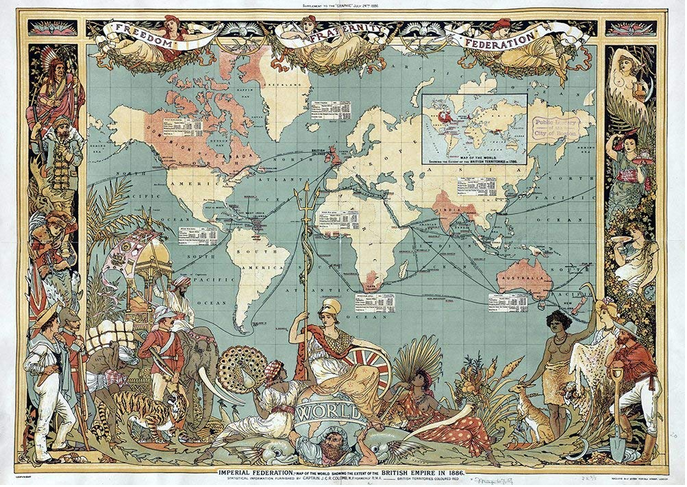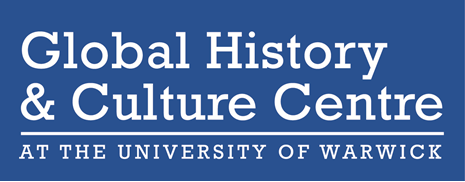Between and Beyond: Transnational Networks and the British Empire (18th-20th Century)
Published: 25 September 2018 - Somak Biswas and Guillemette Crouzet
Between and Beyond: Transnational Networks and the British Empire (18th-20th Century): Notes from a Workshop
Why the Transnational?
The ‘transnational’ is an old theme in British imperial history, though continually reinventing itself in new interventions and guises. Our two-day workshop, Between and Beyond: Transnational Networks and the British Empire engaged with a number of important conceptual and historiographical questions in the field of British imperial history. What role does the British empire play in the facilitation of networks within, without and beyond its boundaries? Do we need to think of the networks of the British Empire following Tony Ballantyne’s metaphor of a “web”?[1] Is the web of networks in the British Empire made of only main arteries or of “multiple filaments”, to cite again Tony Ballantyne?
What does ‘transnational’ bring to the field of imperial studies, particularly when posited with the ever-expanding category of the ‘global’? Interrogating its reach and relevance in a roundtable which took place in the afternoon of the first day, James Poskett and Anne Gerritsen, both global historians, argued that ‘transnational’ offers little analytical traction in a time of Empire. Given that the British Empire subsumed large swathes of the world as part of a unified, however messily managed, supra-unit, any discussion on the transnational would seem anachronistic as the national was yet to be emergent outside of the Americas (and Europe). Gerritsen added that we might look through a more global lens instead, where the British Empire was part of a larger phenomenon, and its networks, flows and mobilities, made sense only when seen as a larger historical process that made the transnational possible in the 20th century.
Several participants and members of the audience made counter-arguments. Even if the empire constituted as yet undefined national entities, anti-colonial nationalist discourse was already imagining itself as a nation and the aspiration to ‘national’ was also, in effect, producing the ‘transnational’. Discourses of migration, trade and networks are replete with such transnational actors, whose crossings defined the cultural imaginaries they were transcending, as well as those crossed into. Others, building on Sarah Hodges and Stephen Legg, suggested how the transnational can offer a critique of the global and its universalist assumptions, and this mutual critique can constitutively enrich both approaches. [2]
Networks in Practice
Almost all the panels shed light on how new networks were created, negotiated and sustained by the British Empire, sometimes undermining older networks and at other times building new ones. Katherine Roscoe and Derek Elliot showed how the penal and carceral system of the British Empire created a specific network of penal colonies, connecting Britain, India, East Africa and the Pacific. The islands on the east and west coast of Australia which served as penal colonies gradually became spatially “autonomous” and became integrated to the new global penal regimes of the British Empire in the 19th century. In so doing, Roscoe and Elliot threw light on how white convict labour narratives came to overwrite aboriginal convict labour in the making of empire.
James Wilson’s paper illustrated how the British (and Dutch) Empires instrumentalised, in the late eighteenth century, Chinese migrant labour for the purposes of agricultural expansion in Ceylon, China and Java. Aditya Ramesh’s paper charted the making of a new kind of sovereignty around rice as a commodity in South India and the “labour network” it fostered, connecting the Madras Presidency, Burma and the Indian Ocean at the beginning of the twentieth century. Ramesh’s paper showed how the transnational circulation of rice deeply inflected its local practices of patronage on different territories of the British Empire.
One of the challenges of the conference was to pay attention to all “networks” and to the “multiple filaments” of the web. Our aim was to chart the structure of the web and to examine the networks created by movements of goods, ideas and people. Furthermore, a second challenge was to consider not only the networks of elites, but also the ones associated with “subaltern lives”, to cite Clare Anderson.[3] To seize the plurality and diversity of the Empire’s networks, panels and discussions were built around a constant dialogue between the global and micro scales. Through a fascinating reconstruction of the convict Charles Bony Anderson’s life, Derek Elliot’s paper demonstrated the necessity of conducting a micro-scale analysis to chart the complexity of convict networks, connecting India, Africa and Australia.
The micro and macro scales also proved useful to analyse the role of diasporic communities, their politics and their interactive networks. Somak Biswas and Cao Yin’s papers posited how such extra-territorial entities and their imaginations connected the politics of the mainland to its diasporic peripheries. Biswas showed how British Indophile figures became interlocutors to mobilise a transnational discourse against indenture, linking British, Indian and diasporic communities; while Yin charted the “resistance” of the Sikh network, which continuously enabled Sikh communities in India and in Southeast Asia to remain in contact and shaped their investments in empire. Jochen Lingelbach’s paper on Polish refugees during the Second World War added to this frame. Lingelbach examined how Polish diasporic politics functioned through a network of community demands, imperial logics and local scales of concern. Alison Okuda, in a different but related move, studied the pedagogic politics of empire manifest in the migrants of the Windrush generations.
The panel on Capital, Finance and Religion made explicit the links between imperial governance, non-government actors and capitalist expansion. John Slight and Arun Kumar, in different ways, argued that piety went hand in hand with networks of capital, through migrant Muslim communities and Christian missionaries in the Empire. Christian Velasco posited that British and Indian banking interventions in East Africa brought forth protocols of a new financial modernity inexorably tied up in the practices of migration and war time contingencies. Analysing the Empire’s reaction to the phylloxéra crisis and its comparative effects on two major imperial vineyards in Australia and South Africa, Chelsea Davis demonstrated that capitalist expansion depended crucially on imperial networks of technology and expertise. Imperial government representatives in Australia and South Africa not only encouraged leading French experts to come to the infected vineyards to provide their expertise, but also rewarded local farmers who fought actively against this very destructive parasite.
Davis’s paper highlighted the convergence of imperial networks between France and Britain in terms of technology, and exchanges of expert-knowledge in a moment of severe crisis for vineyards in the French and British Empires. Cheri Kuncheria’s paper enlarged the debate through a fascinating study of the politics of production and propaganda around the ‘Empire Tobacco’, produced in India. Kuncheria argued that the creation of Indian tobacco as the ‘Empire Tobacco’ was directly pitched against tobacco produced in Virginia and Rhodesia and enabled Britain to control world markets. This imperial policy around tobacco triggered a vehement reaction of the US Government, worried about the fate of US tobacco.
That all imperial formulations rest on and are haunted by anxieties have been well established by scholars such as the late Christopher Bayly and Ann Laura Stoler, and more recently by Kim Wagner and Mark Condos.[4] They have variously argued how carnality, rumours and tensions played an important part in the everyday life of Empire and its administration. In her keynote, Anna Greenwood reminded us that “the Empire was messy” and “uncertain”. Brian Wallace’s study of transnational siege narratives illustrated these anxieties that undergirded exercises of frontier-making. Narratives of the 1857 mutiny and the “dramatic” “fake” news attached to it played a key role in this “network” of anxieties – used to invoke British cultural imagination. Thomas Simpson suggested that this invocation of the “edgy empire”, the frontiers, the garrison places and the borderlands had a key importance in the collective imaginary of the Empire.
Christopher Bayly and Simon Potter have argued that the term “transnational” needs to be used carefully to discuss the existence of imperial networks.[5] The last panel emphasized this creative tension between the global and the national through discourses and practices of typography, mental hygiene and mothercraft. Vaibhav Singh, Ranjana Saha and Shilpi Rajpal explored the many interpellations that rose from Indian negotiations of major western deployments. Singh’s focus on typography, Saha’s on mothercraft and Rajpal’s on mental hygiene captured larger histories of colonial modernity – through the advent of such practices as typesetting, clocked feeding and the rise of the asylum.
Clare Midgley, our last keynote speaker ended with a suggestion for reading networks of transnational solidarity – between British feminists and their colonial counterparts – as part of a wider cosmopolitan feminist gesture.
Conclusion
At the close of the two-day-long workshop, we had raised more questions than we were able to answer. Should the terms “trans-imperial” or “trans-territorial” be more appropriate in describing the complexities of these movements? How do we de-centre Europeanist assumptions that underlie transnational history even as we own it? If we situate the British Empire as part of a larger imperial history, what problems and politics belie such a move? Anne Gerritsen’s suggestion that we can be critical of our affiliations without reifying them gave us hope. That a transnational approach is relevant was amply attested to by young historians in the diversity of topics, themes and insights gleaned; what was clear though was the need for sharper critical engagements with our analytical apparatus – instead of being held captive by our own disciplinary categories.
For more details about the conference, see:https://warwick.ac.uk/fac/arts/history/ghcc/event/bnb
Somak Biswas is a Doctoral student of History at the University of Warwick. His research looks at British Indophile networks and the cultural politics of intimacy in early 20th century India. He is broadly interested in the macropolitics of empire and imperial networks and its intersections with everyday practices and emotional regimes, focusing on a cluster of major Indian figures such as Gandhi and their circle of Western disciples. Somak has a deep interest in public history and student politics, and runs the Queer History Reading Group at Warwick.
Guillemette Crouzet has been a Newton International postdoctoral fellow at the History Department at the University of Warwick since 2017. She is an historian of the British empire, the Middle East and India in the nineteenth and twentieth centuries. She received her PhD from the Sorbonne (Paris), and has undertaken research and teaching work through prestigious fellowships at the European University Institute in Florence, Sciences Po Paris, and the Graduate Institute (University of Geneva). Her prize-winning first book, Genèses du Moyen-Orient. Le Golfe Persique à l'âge des impérialismes, was published in 2015.
[1] Tony Ballantyne, ‘Rereading the Archive and Opening Up the Nation-State: Colonial Knowledge in South Asia (and Beyond),’ in After the Imperial Turn: Thinking with and through the Nation, ed. Antoinette Burton (Durham, N.C.: Duke University Press, 2003)
[2] Sarah Hodges, ‘The Global Menace’, Social History of Medicine (2012) 25/3, pp. 719-728; Stephen Legg, ‘Transnationalism and the Scalar Politics of Imperialism’, New Global Studies (2010) 4/1, pp. 1-7.
[3] Clare Anderson, Subaltern Lives Biographies of Colonialism in the Indian Ocean World, 1790–1920, (Cambridge: Cambrige University Press, 2012).
[4] See Christopher A. Bayly, Empire and Information: Intelligence Gathering and Social Communication in India, 1780-1870 (Cambridge: Cambridge University Press, 1996); Ann Laura Stoler, Along the Archival Grain: Epistemic Anxieties and Colonial Common Sense (Princeton, NJ: Princeton University Press, 2009); Kim Wagner, The Great Fear of 1857: Rumours, Conspiracies and the Making of the Indian Uprising (Oxford: Peter Lang Oxford, 2010); Mark Condos, The Insecurity State: Punjab and the Making of Colonial Power in British India, 1849-1935 (Cambridge: Cambridge University Press, 2017)
[5] C. A. Bayly, Sven Beckert, Matthew Connelly, Isabel Hofmeyr, Wendy Kozol, and Patricia Seed, ‘AHR Conversation: On Transnational History’, American Historical Review, 111/5 (2006), pp. 1440–1464; Simon Potter, British Imperial History (Palgrave: New York, 2015).

Map of the British Empire, 1886





